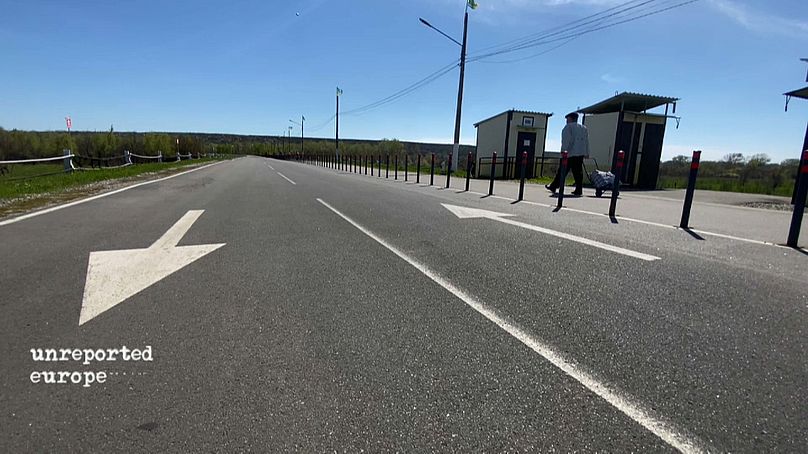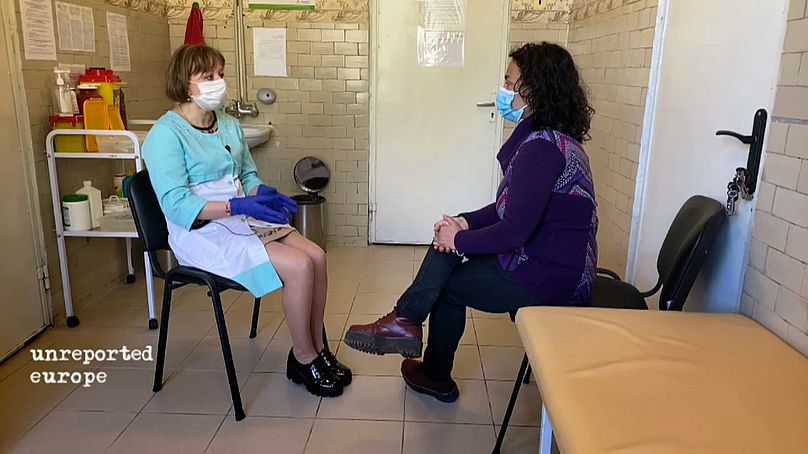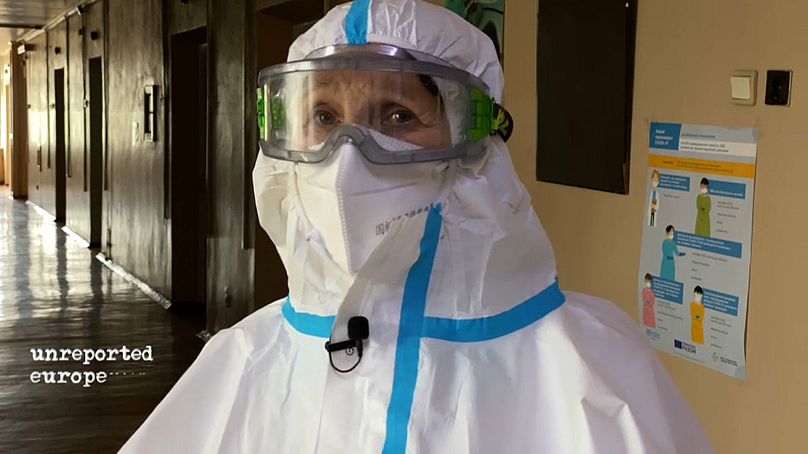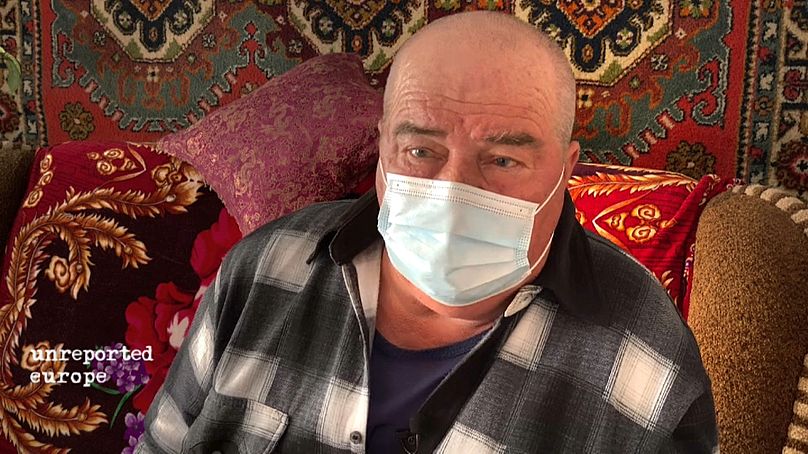Seven years of war in eastern Ukraine have been marked by an escalation of conflict, a Russian military buildup at the border and a new enemy: COVID-19. We take an in-depth look at how people are surviving the pandemic on Europe's only active frontline.
In Eastern Ukraine, people are trying to survive two wars: a seven-year-long conflict between Ukrainian forces and Russian-backed separatists and the pandemic.
In April, an estimated 150 000 Russian troops amassed in the disputed area of Crimea and along the Ukrainian border. The troops did eventually pull back after weeks of military drills, but it was of little comfort to those living in the conflict zone and are in constant fear of escalation.
Ivan Nahorniux, a resident of Vodiane a village close to the contact line between the two fronts, describes living there as if it were "like being in Chernobyl". He feels like nobody wants them or needs them.
The pandemic in a war zone
In Stanytsia Luhanska, in the government-controlled area, the effects of the pandemic are strikingly visible. The town is home to the only pedestrian crossing point along the almost 500-kilometre long line of contact and border between the two fronts.
Freedom of movement has been doubly impacted in Stanytsia Luhanska, first by the war, and now by COVID. Before the pandemic, "up to 17 000 people crossed the checkpoint every day", Olenha Hrekova, a worker for the NGO Right to Protection, tells us. Today less than 2000 use it daily.
Before restrictions, people were able to move between the two sides to get their pensions, see their families and sort out legal problems. Many would even do so on a daily basis to sell their produce. It was a way for them to continue making money during the conflict. Today, that business has been wiped out. On both sides of the conflict, people are poorer and more isolated.
We meet a woman at the Stanytsia Luhanska crossing. She tells us that "not everyone has money to pay for COVID-tests. That’s why people don’t cross without an urgent need". She used to travel twice a year to non-government-controlled areas, but now it's her first time doing so in a year and a half.
The COVID-19 frontline
In Peredilske, just 5 kilometres from the line of contact, there is a medical centre for patients living in the most dangerous areas of eastern Ukraine. The head nurse there, Oksana, says she is doing the job of ten. She's responsible for 1200 people living in two villages. "There is a lack of healthcare staff and with the pandemic we feel this absence even more", she adds.
Fighting the third wave of COVID here is a high-risk job. No COVID tests are available in centres like the one in Peredilske and most of the medical staff have already caught the virus.
The situation there is what Oksana describes as "panic mode". "In the red zones, lots of people got infected everywhere. People don’t even want to go to the doctor".
According to Médicos del Mundo, the already weakened Ukrainian healthcare system requires around 40% more staff to fight the pandemic. This EU-backed NGO says the most urgent needs are not being met. There's a lack of General Practitioners, infectious disease specialists and anesthesiologists.
Serhii Vinohradov who works for Médicos Del Mundo, says that "as a consequence of the conflict, the local health system is lacking the emergency care units for infectious diseases". The units that were organised do not meet health and sanitary requirements.
Even specialist COVID-19 hospitals further away from the line of contact are struggling to cope. The infectious disease hospital in Konstiantinivka increased to maximum capacity, but it still needs more beds and more staff.
Head Doctor Nadiia Scheichenko in Konstiantinivka tells us that the staff is working overtime, "but it's not enough. People are definitely tired".
Oxygen supplies are another huge problem for hospitals in the whole Donetsk region. For example, Konstiantinivka needs 70 to 80 bottles a day to get by, but they can only afford 50.
A rise in critical cases
The number of COVID-19 cases is decreasing in Luhansk and Donetsk, the two regions directly affected by the conflict. The emergency is far from over though. Dr. Scheichenko says that numbers may be down but the cases of critical patients are increasing. Many are simply treated at home without the necessary equipment.
The isolation and the remoteness of some areas has helped to contain the virus. However, difficult living conditions caused by the conflict mean the risk of COVID clusters is a reality.
Poor sanitation
In the village of Opytne, less than a kilometre from the line of contact, the scars of the conflict are everywhere. Before the conflict 800 residents lived there, now only 40 remain. The water and gas have been cut off for almost seven years.
Opytne is COVID-free. Nobody gets in or out without military authorisation. This means that residents are fully dependent on the EU-backed NGO, People in Need, for water that they receive every two weeks. It would be extremely hard for the village residents to tackle the pandemic without access to clean water and proper sanitation.
Over half a million people live in areas directly affected by the armed conflict. 30% of them are elderly. These zones are continually subjected to gunfire exchanges. They're also exposed to landmines and remnants of explosives.
The toll of war and disease
Isolation hasn’t spared many other villages in conflict-affected areas. Ivan was among some of the residents infected in Vodiane. He was taken to a specialist hospital in February and is now recovering. He is one of the lucky ones. Over 12 000 people have been hospitalised in conflict-affected areas since 2020.
Ivan tells us that to him "COVID is like a second war". It seems like everything's fine and then out of thin air someone dies. One moment you are here and the next you are gone".
Hope
Ivan and his wife think the vaccine will save their village, despite Ukraine’s slow vaccination campaign. They tell us that the doctor came and vaccinated one family not long ago, so there is hope this will occur more frequently.
The COVAX initiative is expected to supply 20% of the country’s vaccine needs by the end of the year. That's the equivalent of eight million doses. With this global initiative aiming to make vaccines accessible to all, relief is on its way. Vaccines are the weapon that will help put an end to at least one war in Ukraine.














